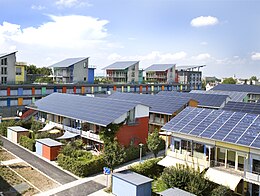
Photovoltaics
Method to produce electricity from solar radiation / From Wikipedia, the free encyclopedia
Dear Wikiwand AI, let's keep it short by simply answering these key questions:
Can you list the top facts and stats about Photovoltaics?
Summarize this article for a 10 years old
Photovoltaics (PV) is the conversion of light into electricity using semiconducting materials that exhibit the photovoltaic effect, a phenomenon studied in physics, photochemistry, and electrochemistry. The photovoltaic effect is commercially used for electricity generation and as photosensors.



A photovoltaic system employs solar modules, each comprising a number of solar cells, which generate electrical power. PV installations may be ground-mounted, rooftop-mounted, wall-mounted or floating. The mount may be fixed or use a solar tracker to follow the sun across the sky.
Photovoltaic technology helps to mitigate climate change because it emits much less carbon dioxide than fossil fuels. Solar PV has specific advantages as an energy source: once installed, its operation does not generate any pollution or any greenhouse gas emissions; it shows scalability in respect of power needs and silicon has large availability in the Earth's crust, although other materials required in PV system manufacture such as silver may constrain further growth in the technology. Other major constraints identified include competition for land use.[1] The use of PV as a main source requires energy storage systems or global distribution by high-voltage direct current power lines causing additional costs, and also has a number of other specific disadvantages such as variable power generation which have to be balanced. Production and installation does cause some pollution and greenhouse gas emissions, though only a fraction of the emissions caused by fossil fuels.
Photovoltaic systems have long been used in specialized applications as stand-alone installations and grid-connected PV systems have been in use since the 1990s.[2] Photovoltaic modules were first mass-produced in 2000, when the German government funded a one hundred thousand roof program.[3] Decreasing costs has allowed PV to grow as an energy source. This has been partially driven by massive Chinese government investment in developing solar production capacity since 2000, and achieving economies of scale. Improvements in manufacturing technology and efficiency have also led to decreasing costs.[4][5] Net metering and financial incentives, such as preferential feed-in tariffs for solar-generated electricity, have supported solar PV installations in many countries.[6] Panel prices dropped by a factor of 4 between 2004 and 2011. Module prices dropped by about 90% over the 2010s.
In 2022, worldwide installed PV capacity increased to more than 1 terawatt (TW) covering nearly two percent of global electricity demand.[7] After hydro and wind powers, PV is the third renewable energy source in terms of global capacity. In 2022, the International Energy Agency expected a growth by over 1 TW from 2022 to 2027.[8] In some instances, PV has offered the cheapest source of electrical power in regions with a high solar potential, with a bid for pricing as low as 0.015 US$/kWh in Qatar in 2023.[9] In 2023, the International Energy Agency stated in its World Energy Outlook that ‘[f]or projects with low cost financing that tap high quality resources, solar PV is now the cheapest source of electricity in history.[10]